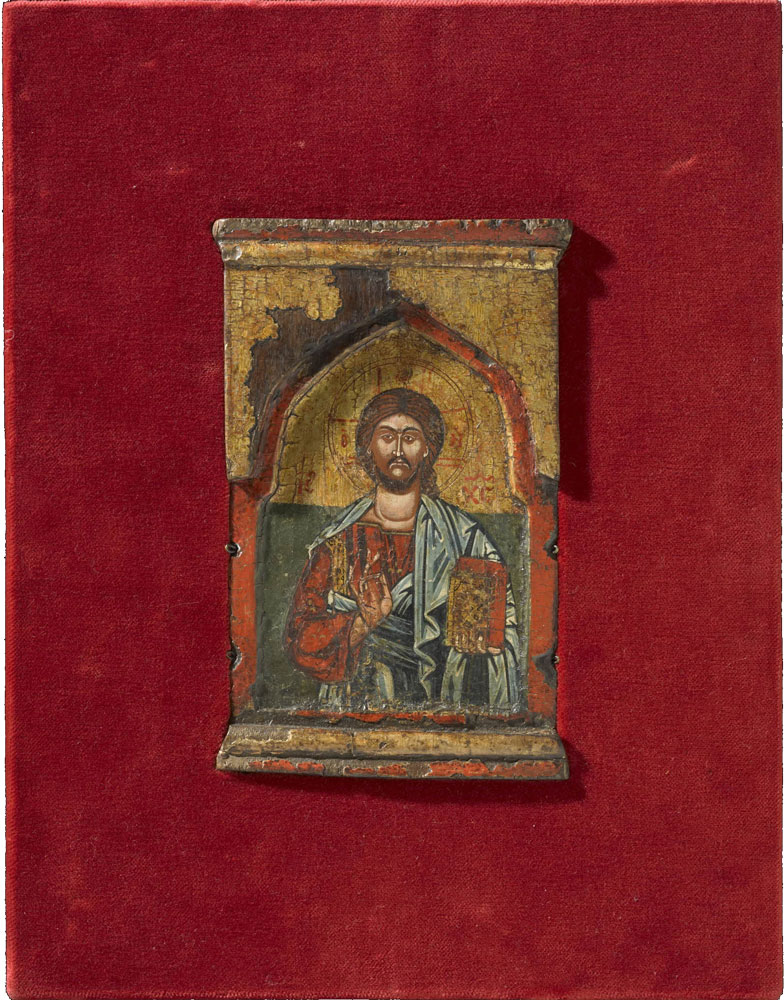
Icon with Christ Pantokrator
Origin
Greece (perhaps Kastoria)
Object Date
17th century
Metric Dims
18.3cm; W. 11.1cm
Inventory Number
Reg. no. BEP 1998,1105.7
Additional Details
(Cormack 86)
Provenance
Given by Ella Wentworth Dyne Steel in 1998.

Origin
Greece (perhaps Kastoria)
Object Date
17th century
Metric Dims
18.3cm; W. 11.1cm
Inventory Number
Reg. no. BEP 1998,1105.7
Additional Details
(Cormack 86)
Provenance
Given by Ella Wentworth Dyne Steel in 1998.
The icon is painted in egg tempera with gold leaf on wood primed with gesso. This very small panel represents a half-length image of Christ. Christ is holding a closed Gospel book with his left hand whilst raising the other in a gesture of blessing. He is clad in a light-blue himation (cloak) over a red chiton (tunic) decorated with a golden clavus (band). His halo is defined by two deeply incised circles within which is the symbol of the cross bearing the Greek inscription Ο ω Ν (‘He Who Is’). On either side of Christ are the customary abbreviation IC XC (Jesus Christ). A raised integral pointed arch, coloured red, frames the figure. The spandrels of the frame are decorated with gilding, which is now partly destroyed. The work was clearly an object of private devotion, and once the central part of a portable triptych as suggested by its shape and metal hinges on the sides. The reverse has been painted.
This is a standard iconography in bust images of Christ over a long period, and so the dating and provenance of the panel will rely on the typology and decoration of the frame as well as the style of painting. The simple carving of the panel, forming an arch to frame the figure, was widespread in northern Greece between the 16th and 18th centuries, as seen in objects from the Demetrios Ekonomopoulos collection at the Museum of Byzantine Culture, Thessaloniki (Baltoyanni 1986, nos 59, 249, 294, pls 139, 194, 197) and the Georgios Tsakyroglou collection in Athens (Karakatsani 1980). The decoration of the side edges of the icon with transverse alternating strips of red and blue is also found on the border of a 17th-century icon of the Three Hierarchs attributed to a workshop in either Epiros or elsewhere in northern Greece, now part of the Evangelos Averof collection (Vassilaki 2012).
On the figure itself, the use of thick outlines, the linear handling of the hair, the geometric rendering of the drapery folds and the use of bright red colours indicate a 17th-century painter in northern Greece. Also, the painting of the background—half in gold and half in green—is found on a number of icons with saints in bust format from that area and dating to around the same period, such as that with Sts Andrew, George and Anastasia from the Ekonomopoulos collection (Baltoyanni 1986, nos 35, 63, 116, pls 46, 57, 47). The modelling of Christ’s face with broad areas of ochre and pastel pink over brown is also indicative of that period and place. What is more, the long straight nose, highlighted with a continuous line of ochre, the fine lines denoting the eyelids as well as the curved highlights in the area between the lower lip and the moustache find close parallels in painted churches of Kastoria. Such features are found, for example, in the figure of St Artemios from the narthex frescoes of the Church of St Nicholas of the Archontissa Palaiologina in Kastoria dating to 1663 (Paisidou 2002). These stylistic features are found in later works from northern Greece such as the central panel of a small triptych with Christ Pantokrator from the Ekonomopoulos collection, dated to the 18th century (Baltoyanni 1986, 112, no. 269, pl. 179).
This small panel in the BM collection is therefore perhaps the work of a 17th-century painter working in the area of Kastoria, which was a flourishing artistic centre at the time.
Literature: A. Karakatsanis, Εικόνες συλλογής Γεωργίου Τσακύρογλου, Athens, 1980, 176, 188, no. 225; 178, 205, no. 278; 179, 209, no. 289; C. Baltoyanni, Icons. Demetrios Ekonomopoulos Collection, Athens, 1986; M.P. Paisidou, Οι τοιχογραφίες του 17ου αιώνα στους ναούς της Καστοριάς. Συμβολή στη μελέτη της μνημειακής ζωγραφικής της δυτικής Μακεδονίας, Athens, 2002, 36–7, pl. 18b; R. Cormack, Icons, London, 2007 (repr. 2014), 134, no. 86; M. Vassilaki, Οι εικόνες του Αρχοντικού Τοσίτσα: η συλλογή του Ευαγγέλου Αβέρωφ, Athens, 2012, 179–80, no. 23.
Eleni Dimitriadou